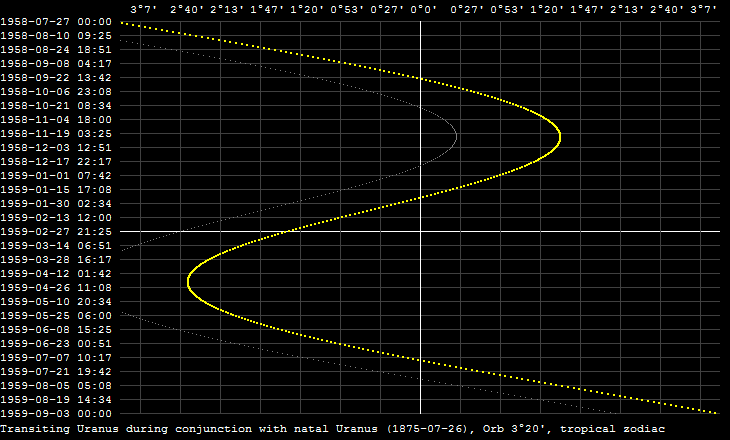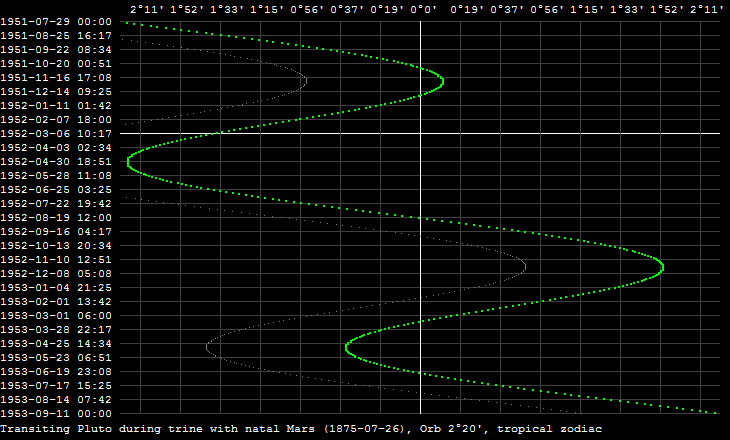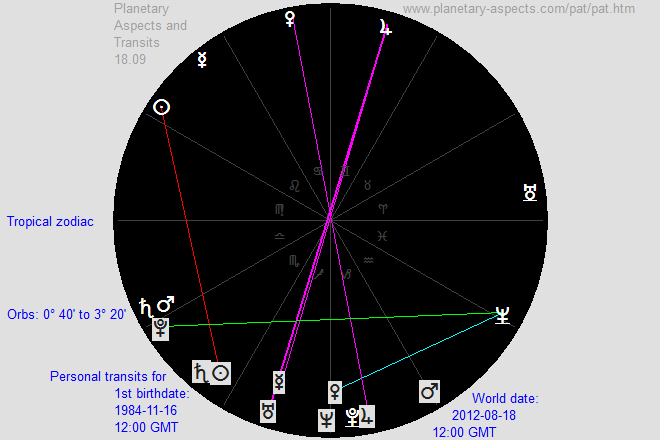astrologer50
Banned
Before learning about how transits work,you really need to learn how to use an ephemeris what idenetify with what all the 'glyphs' are and what they represent...
http://www.astrologyweekly.com/forum/showthread.php?t=42496
here is my favourite online ephemeris which plots where the planets are for hundreds of years...
Transits
I use--- 1° approaching, 1° exact and 1° departing. If you click on the link listed below for the online ephemeris it will list all planets at any given time. Learning astrology is like learning a new ‘language’ and obviously the more effort you put into something the more your knowledge and understanding will increase. All transits act as ‘background’ influences through a house, until it makes a mathematical aspect to a planet inside or an Angle.
For 'timings' I would look to the retrograde hit as the most important trigger, then look to see what the quicker planets are doing especially mars & mercury --
astro.com has fee six month transit forecast plus when you get into Extended chart selection, look at the three tabs after calculating a chart under ‘method’ default is circular wheels (on left), middle is special charts and in their you get graphic ephemeris 1yr (or 5years) with natal = transits for 1yr and lots more. BUT you first must learn or memorise the 'glyphs' ie: shorthand for recognising what these maps/graphics mean.
For example when you post or reply to a chart the 'smilies' to the right and just under them [more] if you click on there it will bring up a whole loads of 'glyphs' Mercury Uranus conjunction (+or - 8') trine aspect 120' Libra
http://cafeastrology.com/transits.html
http://cafeastrology.com/transits_2.html
http://www.khaldea.com/ephemcenter.shtml
http://www.bobmarksastrologer.com/transits18.0.htm
http://www.astro.com/faq/fq_fh_transits_e.htm
http://www.astro.com/astrology/in_transits_e.htm
http://www.astro.com/swisseph/ae/2000/ae_2009.pdf
http://www.astrologyweekly.com/learn-astrology/astrology-glyphs.php
http://www.dkfoundation.co.uk/dkfoundation/BookTransitsAndProgressions.htm
Now it's more important to focus on transits from Jupiter to Pluto (poss mars as this is the ignition key)and these planets when aspecting something in your natal chart 'set off' the difficult or nice 'aspects - potential - problems' that your chart expresses. By that I mean if a benefic planet like Jupiter hits/touches/transits your venus, mars or uranus these could be experienced very pleasantly. BUT if your natal venus is afflicted, or badly aspected say conj saturn then jupiter will not has such a good effect. It all depends on how the natal planet is 'aspected'
For me I would say external 'events' must be seen by transits, progressions or Solar arcs to Angles ie: Asc/Desc & MC/IC most other times these events are 'internal, psychological matters as in between the ears'
Now astro.com uses a much wider orb, possibly something like 10° that’s why when you use the free transit forecast service a transit goes on for months and months. BUT common sense should tell you when the transit is ‘exact’ then it’s at the strongest. Some astrologers swear by 1° approaching produces ‘events’ some say the 1° exact, some say 1° off for triggering events. I personally look to the exact and 1° off for ‘timings’ especially the retrograde hit (backwards hit)
This last website link is rather nice because it gives interpretations of what the ‘Lord’ of the house cusp ruler means ie: T Jupiter sextiles natal sun, so wherever Leo rules in your chart is connected to the area this transit will be affecting –
http://www.astrology-x-files.com/transits/
Next to make sure there is no confusion between other modalities, like secondary progressions. there is already a sticky explaining these..
progressed planets
http://www.astrologyweekly.com/forum/showpost.php?p=266189&postcount=8
http://www.astrologyweekly.com/forum/showthread.php?t=42496
here is my favourite online ephemeris which plots where the planets are for hundreds of years...
Transits
I use--- 1° approaching, 1° exact and 1° departing. If you click on the link listed below for the online ephemeris it will list all planets at any given time. Learning astrology is like learning a new ‘language’ and obviously the more effort you put into something the more your knowledge and understanding will increase. All transits act as ‘background’ influences through a house, until it makes a mathematical aspect to a planet inside or an Angle.
For 'timings' I would look to the retrograde hit as the most important trigger, then look to see what the quicker planets are doing especially mars & mercury --
astro.com has fee six month transit forecast plus when you get into Extended chart selection, look at the three tabs after calculating a chart under ‘method’ default is circular wheels (on left), middle is special charts and in their you get graphic ephemeris 1yr (or 5years) with natal = transits for 1yr and lots more. BUT you first must learn or memorise the 'glyphs' ie: shorthand for recognising what these maps/graphics mean.
For example when you post or reply to a chart the 'smilies' to the right and just under them [more] if you click on there it will bring up a whole loads of 'glyphs' Mercury Uranus conjunction (+or - 8') trine aspect 120' Libra
http://cafeastrology.com/transits.html
http://cafeastrology.com/transits_2.html
http://www.khaldea.com/ephemcenter.shtml
http://www.bobmarksastrologer.com/transits18.0.htm
http://www.astro.com/faq/fq_fh_transits_e.htm
http://www.astro.com/astrology/in_transits_e.htm
http://www.astro.com/swisseph/ae/2000/ae_2009.pdf
http://www.astrologyweekly.com/learn-astrology/astrology-glyphs.php
http://www.dkfoundation.co.uk/dkfoundation/BookTransitsAndProgressions.htm
Now it's more important to focus on transits from Jupiter to Pluto (poss mars as this is the ignition key)and these planets when aspecting something in your natal chart 'set off' the difficult or nice 'aspects - potential - problems' that your chart expresses. By that I mean if a benefic planet like Jupiter hits/touches/transits your venus, mars or uranus these could be experienced very pleasantly. BUT if your natal venus is afflicted, or badly aspected say conj saturn then jupiter will not has such a good effect. It all depends on how the natal planet is 'aspected'
For me I would say external 'events' must be seen by transits, progressions or Solar arcs to Angles ie: Asc/Desc & MC/IC most other times these events are 'internal, psychological matters as in between the ears'
Now astro.com uses a much wider orb, possibly something like 10° that’s why when you use the free transit forecast service a transit goes on for months and months. BUT common sense should tell you when the transit is ‘exact’ then it’s at the strongest. Some astrologers swear by 1° approaching produces ‘events’ some say the 1° exact, some say 1° off for triggering events. I personally look to the exact and 1° off for ‘timings’ especially the retrograde hit (backwards hit)
This last website link is rather nice because it gives interpretations of what the ‘Lord’ of the house cusp ruler means ie: T Jupiter sextiles natal sun, so wherever Leo rules in your chart is connected to the area this transit will be affecting –
http://www.astrology-x-files.com/transits/
Next to make sure there is no confusion between other modalities, like secondary progressions. there is already a sticky explaining these..
progressed planets
http://www.astrologyweekly.com/forum/showpost.php?p=266189&postcount=8




